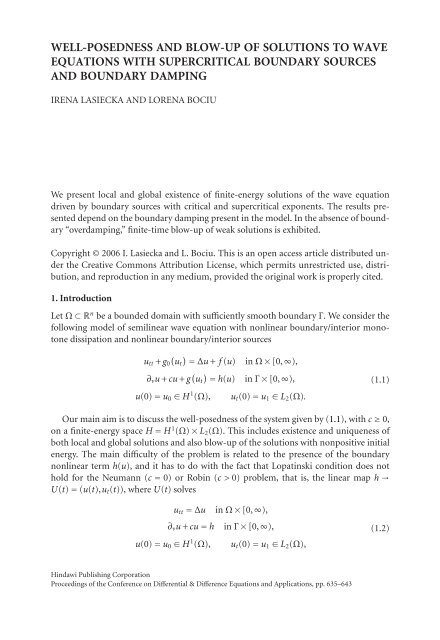DIFFERENtIAl & DIFFERENCE EqUAtIONS ANd APPlICAtIONS
DIFFERENtIAl & DIFFERENCE EqUAtIONS ANd APPlICAtIONS
DIFFERENtIAl & DIFFERENCE EqUAtIONS ANd APPlICAtIONS
Create successful ePaper yourself
Turn your PDF publications into a flip-book with our unique Google optimized e-Paper software.
WELL-POSEDNESS AND BLOW-UP OF SOLUTIONS TO WAVE<br />
EQUATIONS WITH SUPERCRITICAL BOUNDARY SOURCES<br />
AND BOUNDARY DAMPING<br />
IRENA LASIECKA AND LORENA BOCIU<br />
We present local and global existence of finite-energy solutions of the wave equation<br />
driven by boundary sources with critical and supercritical exponents. The results presented<br />
depend on the boundary damping present in the model. In the absence of boundary<br />
“overdamping,” finite-time blow-up of weak solutions is exhibited.<br />
Copyright © 2006 I. Lasiecka and L. Bociu. This is an open access article distributed under<br />
the Creative Commons Attribution License, which permits unrestricted use, distribution,<br />
and reproduction in any medium, provided the original work is properly cited.<br />
1. Introduction<br />
Let Ω ⊂ R n be a bounded domain with sufficiently smooth boundary Γ. We consider the<br />
following model of semilinear wave equation with nonlinear boundary/interior monotone<br />
dissipation and nonlinear boundary/interior sources<br />
( )<br />
u tt + g 0 ut = Δu + f (u) inΩ × [0,∞),<br />
∂ ν u + cu + g ( )<br />
u t = h(u) inΓ × [0,∞),<br />
u(0) = u 0 ∈ H 1 (Ω), u t (0) = u 1 ∈ L 2 (Ω).<br />
(1.1)<br />
Our main aim is to discuss the well-posedness of the system given by (1.1), with c ≥ 0,<br />
on a finite-energy space H = H 1 (Ω) × L 2 (Ω). This includes existence and uniqueness of<br />
both local and global solutions and also blow-up of the solutions with nonpositive initial<br />
energy. The main difficultyoftheproblemisrelatedtothepresenceoftheboundary<br />
nonlinear term h(u), and it has to do with the fact that Lopatinski condition does not<br />
hold for the Neumann (c = 0) or Robin (c >0) problem, that is, the linear map h →<br />
U(t) = (u(t),u t (t)), where U(t)solves<br />
u tt = Δu in Ω × [0,∞),<br />
∂ ν u + cu = h in Γ × [0,∞),<br />
u(0) = u 0 ∈ H 1 (Ω), u t (0) = u 1 ∈ L 2 (Ω),<br />
(1.2)<br />
Hindawi Publishing Corporation<br />
Proceedings of the Conference on Differential & Difference Equations and Applications, pp. 635–643

















